Connext Ecosystem #3: NFTHashi
A deep dive into NFTHashi: What is it, a brief history, the future of cross-chain NFTs, and why Connext was chosen
What is NFTHashi?
NFTHashi is a simple, versatile, and trust-minimized cross-chain bridge that supports transferring the NFTs between the different chains.
Connext's Amarok is used for cross-chain messages.
A Brief History
NFTHashi has been started being developed at a hackathon back in April 2022; ETHAmsterdam of ETHGlobal.
The team challenged the cross-chain NFT implementation using Connext and continued developing and releasing NFTHashi.
Background of the team:
We are BlockBase; a blockchain dev company based in Japan. First, we started building the NFT minting platform Chocomint, supporting multiple EVM chains to mint NFT, and we wanted to add cross-chain functionality with Connext so that user does not worry about which chain to deploy their NFT. That’s how the idea of NFTHashi was born. — said Taiju Sanagi from NFTHashi.
NFTHashi aims to solve a couple of problems:
Users have to pay high gas prices to trade NFTs on Ethereum, even though there are more solutions such as L2 and sidechain
Most NFTs are currently concentrated in the Ethereum blockchain, making it difficult for the emerging chains to activate their NFT ecosystems
A closed ecosystem in the original chain of the NFTs
The Future is Cross-Chain NFTs
The increasing number of L2s and chains will lead to a fragmentation of users, data, and liquidity, and the importance of asset bridging will keep increasing.
Every blockchain product will move towards being able to support cross-chain use cases.
The cross-chain NFT market is currently untapped, with the potential to cross-pollinate multiple communities in every domain.
Cross-chain NFTs can create many new use cases that did not exist before:
Cross-chain NFT games
Cross-chain NFT collections
Cross-chain NFT governance
Cross-chain NFT marketplaces
Cross-chain lending using NFTs as collateral
How it works:
A message is passed by a relayer between 2 chains but, there is a 30 minutes latency period before it becomes valid. Any watcher can prove that the message is invalid and slash it during this time.
It’s a fraud-proof system of optimistic rollups by Connext.
Why Connext was chosen?
Trust Minimization and Security
Connext Network was chosen because of the minimized trust assumptions in its security model.
Connext provides trust-minimized cross-chain messaging and it’s built on Nomad - an optimistic communication protocol that requires only 1 good actor in the space to remain secure. This is the most trust-minimized solution currently available beyond native bridges (Ethereum-L2s, IBC) that are not available across separate domains.
Connext bridge and interoperability protocol are the most secure design among EVM-compatible chains.
The Connext architecture is based on smart contracts, and a process flow that prevents anyone from losing funds, or even worse, from getting them stolen.
How can you build your own xChain Application with Connext?


STEP 1: First, learn what are xApps
STEP 2: Learn about building cross-chain apps and what you can build
STEP 3: Let’s get more technical! Here is the xApp starter kit
STEP 4: You want to test your knowledge and have fun in hackathons with Connext? Sure, here is our:
STEP 5: You started building a xApp and want to step up your game with some help? Apply for a grant from Connext Network!
NFTHashi SDK
NFTHashi provides the contract integrated bridge function as SDK for the users who want to create a more advanced NFT utilizing cross-chain.
If you are a creator, it is easy to create NFTs that are natively cross-chain by adding the NFTHashi SDK into the NFT contract:
A chain with minted NFTs,
A chain with current NFTs,
The itinerancy of NFT bridges,
Other NFTs whose metadata changes according to these attributes.
How to deploy the SDK? Learn here.
Try NFTHashi’s Testnet.
How to use NFTHashi? Learn here.
More About NFTHashi
Website | Blog | Docs | Twitter | Discord
About Connext
Connext is a network for fast, trustless communication between chains and rollups. It is the only interoperability system of its type that does this cheaply and quickly without introducing any new trust assumptions. Connext is aimed at developers looking to build bridges and other natively cross-chain applications. To date, over $1.5b in transactions have crossed the network.








